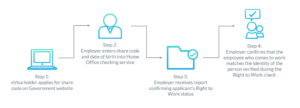Digital Right to Work checks – a guide for employers

In early 2022, the Government updated Right to Work guidance and launched a digital Right to Work Scheme to further facilitate online Right to Work (RtW) checks.
The digital Scheme allows employers to remotely verify the identity of people with applicable documents using an Identity Service Provider (IDSP).
Employers can now decide whether to:
- Introduce digital checks for eligible applicants (the digital Scheme is optional for UK/Irish in-date passport holders).
- To return to Right to Work checks using physical documents.
- To combine the two checking methods.
The choice you make will depend on the demographic of your applicants and your internal recruitment processes.
What is a Digital Right to Work check?
A digital Right to Work check allows applicants with applicable proof of identity to verify their identity and prove their Right to Work remotely, instead of presenting physical documents to you as an employer.
UK & Irish citizens
Under the new digital Scheme, an employer can carry out a Right to Work check on holders of UK & Irish in-date biometric passports and passport cards using Identity Document Validation Technology (IDVT) from an IDSP. The IDSP will share a report for your records, confirming the authenticity of the document and whether it gives eligibility to work in the UK.
The report which you receive from your chosen IDSP should confirm the authenticity of an identity document and show that the relevant Medium Level of Confidence (MLoC) standard has been met.
Interested in how we conduct Digital checks?
Read our blog explaining our process

Non-UK/Irish citizens with an eVisa
Anyone with a UK Visas and Immigration (UKVI) account – including those who applied to the EU Settlement scheme – can now access their immigration status online through an eVisa. To check an eVisa, an employer must use a share code provided by an applicant. (More about share codes below)

Confirming the identity of your applicant
If you’re carrying out a digital Right to Work check, you won’t see an applicant’s original document or the person who is uploading it. So, it’s important to ensure that you check that the employee matches the applicant to avoid ‘imposter fraud’, i.e., an applicant using a legitimate proof of Right to Work which doesn’t belong to them.
To comply with the UK/Irish digital check Scheme, it’s essential to add biometric facial matching – so that the IDSP can match a selfie image to the image of your applicant used in the identity verification.
As part of a compliant digital check, the employer themselves must then also confirm that the employee who turns up to work matches the identity of the person who has been verified during the Right to Work check. You must confirm this by seeing the person in a face-to-face meeting or over a video call when they start work for you.
Likewise, when checking an eVisa, make sure you carefully inspect the image of your applicant on the report to ensure it matches your employee.
What’s a share code and how do you check one?
Migrant workers can prove their Right to Work to a potential employer by giving them a ‘share code’. EU, EEA or Swiss citizens granted status under the EU Settlement Scheme or anyone with a UKVI account can generate a share code through the Government ‘View and Prove’ service. A share code is usually valid for 90 days and is made of 9 alphanumeric characters – for Right to Work checks, it will begin with a W.
Employers can access the Home Office online checking service and use the share code, along with an applicant’s date of birth, to check details of their Right to Work in the UK, including any restrictions, for example, on the hours an applicant can work or the type of work they can do. Some IDSPs, including TrustID, have an interface into the checking service to help an employer check all applicants through a single platform.
Please Note: It is not sufficient to view the information provided to the employee when they view their own profile on the Home Office online right to work checking service. You will not have a Statutory Excuse if you accept documents such as a screenshot image from a candidate’s online EU Settled Status (EUSS) account, a printout of an employee’s Right to Work status from the EUSS scheme or a Home Office confirmation letter, stating they have been granted pre-settled or settled status.
What should you do next?
- To find out more about the latest Right to Work guidance, you can visit the Home Office website.
- If you’re interested in introducing the digital Scheme, start by researching IDSPs – there’s a full list here.
The current guidance recommends that you work with a certified IDSP who can provide assurance that they meet relevant scheme guidance and the standards set out in the trust framework. TrustID are a certified IDSP for the Right to Work, Right to Rent and DBS Digital Schemes.
Want to find out more?
If you’d like to find out more, why not download our FAQ document below, visit our Right to Work service page or contact us here.
or
Sign up to receive updates
Receive notifications from TrustID direct to your inbox. Simply fill out your email address in the form below.
Want to find out more?
We’d be really happy to chat through your requirements and offer advice on the best service for your business.
Tel: 0118 466 0822 or email us.
Request a callback


